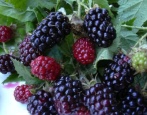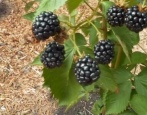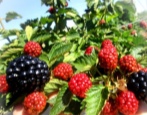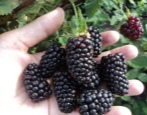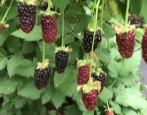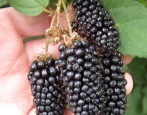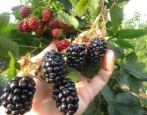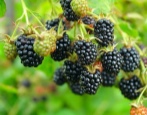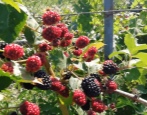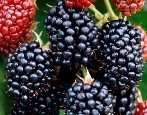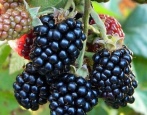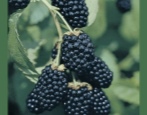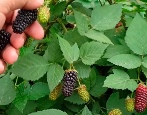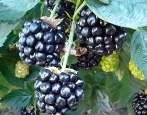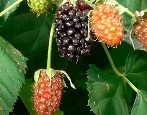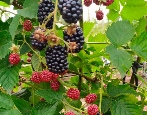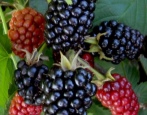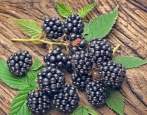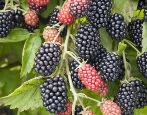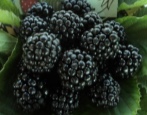
- Authors: New Zealand, Harvey Hall
- Taste: sweet with slightly sour taste
- The presence of thorns: Yes
- Tasting assessment: 4,5
- Berry weight, g: 10-17
- Berry size: large
- Berry color: black with dark purple sheen
- Fruiting period: June-July and harvested within 6-8 weeks
- Yield: 12-15 kg per bush
- Frost resistance, ° C / Winter hardiness: low
Blackberry Karaka Black amazes with the size of its berries, but in care it is a rather capricious plant that is afraid of frost. Despite this, the variety has not become less in demand among gardeners.
Breeding history of the variety
Brought Karak Black in New Zealand. Today we should be grateful for her appearance to the scientist and breeder Harvey Hall.
Description of the variety
The bushes grow compact, with a maximum height of 2 meters. The species described has thorns, so you need to be careful when picking berries.
The foliage is light green. There are teeth on the edges. Long lashes are not cut, which allows you to increase the number of flowers on the shoot.
The internodes are short, for this reason, many fruit buds are formed on the shoots. When the plant begins to bear fruit, it is almost completely covered with massive berries.
Ripening terms
Blackberry bushes begin to bear fruit in June-July. The fruits are harvested within 6-8 weeks. This variety belongs to the early ones.
Yield
From one bush of Karaka Black, you can collect from 12 to 15 kilograms of ripe berries.
The plant begins to bear fruit one year after planting. It comes into full force only for 3-4 years. It was noted that in England up to 35 kilograms of fruit can be harvested from this variety.
Berries and their taste
The berries are great in containers for several days. They can be consumed both fresh and frozen. The fruits are suitable for compotes, juices and jams.
The fruits are black with a purple tint. They taste sweet, but there is a slight sourness.
The pulp of the berries is juicy, dense. The shape of the fruit is like an elongated cylinder. The weight of one berry can reach 10-17 grams.
Growing features
The amount of harvest depends on where exactly the gardener decided to plant the plant, and what quality planting material was chosen.
Site selection and soil preparation
If the seedlings were purchased in a nursery and are in a container, then they can be planted in open ground throughout the season. For good survival, the plant is transferred to the ground along with a lump of earth.
If planting is carried out in a region with a temperate climate, then planting is advised in early spring, before the buds bloom. There is enough time until autumn for the blackberry root system to get stronger and the plant to prepare for winter. If you plant seedlings in the fall, then there is no guarantee that they will take root well and will not die when the first cold weather comes. In the south of our country, late disembarkation is possible, but always a few months before the onset of frost.
Blackberries love the sun, therefore, the appropriate place should be selected for it. The taste and color of berries is highly dependent on the amount of sunlight received. You can grow berries of good taste with light shading, but you should know that the number of fruit buds in such an area is reduced.
The ideal soil for this type of loam, while the pH should be slightly acidic or neutral. Horsetail or sorrel will tell you about the acidic soil on the site.You can change the pH by adding lime. There are 500 grams per square meter of area.
You can even grow blackberries on sandy soil, but at the same time, the gardener will need to constantly apply fertilizer and moisture. This berry will not grow in the lowlands, since there is a lot of moisture after the rain. With a large waterlogged soil, the plant suffers from a fungus.
If the planting of seedlings is planned for the fall, then preparatory work begins in two weeks. If in the spring, then the site is prepared in the fall.
It is advisable to dig up the earth, remove weeds, dig a hole 45x45 cm.This variety does not form many shoots, so it is worth leaving 1-1.5 m between the plants.
The following components are laid on the bottom of the pit:
2 kg of humus;
100 grams of superphosphate;
40 grams of potassium salt, or you can replace it with 100 grams of wood ash.
To improve the rooting process, it is preliminarily advised to immerse the seedlings in the Kornevin solution.
Pruning
After the fruits have been removed from the bushes, the old branches are pruned. There is no need for them anymore, they will only begin to prevent young shoots from growing strong, taking water and trace elements.
In an adult bush, it is enough to leave 6 to 8 branches. Lateral shoots and tops are not pinched, since there are enough fruit branches without it.
Watering and feeding
It is worth watering the blackberry only when there has been no rain for a long time, and only young bushes. Adults have enough moisture anyway, but during periods of severe drought, and when fruits begin to form, watering is indispensable. One-year-old plants are watered once a week.
Frost resistance and preparation for winter
The described variety is not at all adapted to frost, therefore, you cannot do without shelter. The special material is ideal for this.
Diseases and pests
Disease and pest problems can be minimized by eliminating nearby nightshade crops, raspberries, and strawberries. As a preventive treatment, fungicides, copper sulfate and garlic infusion are used. Processing must be carried out 2 times a year: in autumn and spring.
Reproduction
The variety can be propagated in several ways:
layering;
pulping (rooting of the apical buds of the shoots).
You should not expect a large amount of overgrowth from the bushes, but you can deliberately damage the root with a shovel, then the number of young plants will increase.
If we talk about nurseries, then here reproduction is carried out by root or green cuttings.
